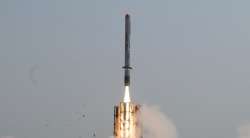After MTCR membership, India to again test indigenous sub-sonic missile ‘Nirbhaya’
After two failures and one partial success, India is planning to test the indigenously designed and developed long range sub-sonic cruise missile ‘Nirbhaya’ once again sometime next month.

After two failures and one partial success, India is planning to test the indigenously designed and developed long range sub-sonic cruise missile ‘Nirbhaya’ once again sometime next month.
According to a report in ‘Sputnik’, the next test of ‘Nirbhaya’ comes after India acquired the membership of the Missile Technology Control Regime (MTCR).
“A low-flight trial (Of Nirbhaya) will be held next month. This will be followed by two more flights. Work on the air variant is on,” Aeronautical Development Establishment Director M V K V Prasad was quoted sa saying by Sputnik.
The report says that India had to depend on indigenous technology so far because it was not a member of MTCR which led to two failures and one partial success.
The missile has recently undergone changes and Indian scientists are geared for a fourth test in December this year.
Indian Defence Ministry had claimed success in some operations that the missile had performed during its last test lasting over 11 minutes.
“DRDO needs to get over the critical challenges experienced in stability of the missile in flight over long range which has led to abortion of the mission twice so far,” defense analyst Brigadier Rahul Bhonsle (retired) told Sputnik.
The report says that, of late, it was speculated that plans to extend the range of Indo-Russian BrahMos missile may sink the Nirbhay project.
However, Brigadier Rahul Bhonsle, does not agree with this viewpoint.
“Technically speaking a BrahMos with extended range and Nirbhay are two separate projects by different agencies. Thus the move to extend the range of BrahMos should not impact the development of the Nirbhay. What is to be decided is do we want two sets of cruise missiles – one with a range of 600 and another 1,000 kms? Is there an operational requirement of the two categories of missiles for the armed forces and is there enough money to develop both?” he said.